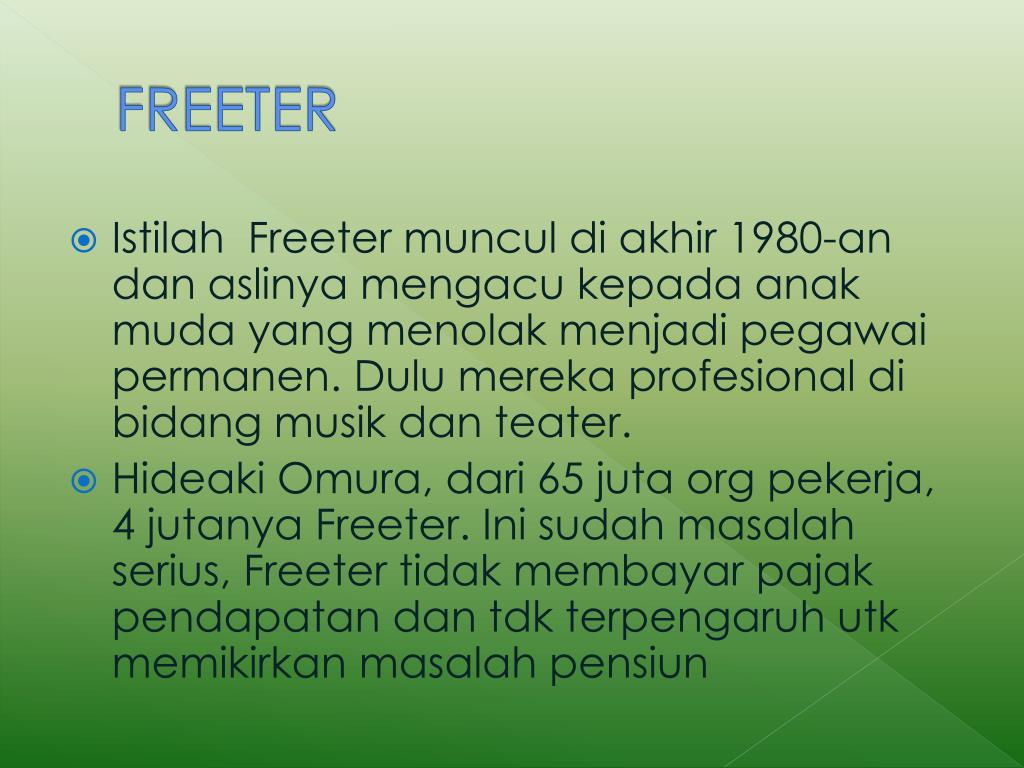

Some experts predict that Japan's aging population will create a labor shortage that will increase career options for freeters. The rise of internet business has allowed some freeters to work from home and be self-employed. Two thirds of freeters have never had a regular, full-time job. According to a survey by the Japan Institute of Labor in 2000, the average freeter works 4.9 days per week and earns ¥139,000 per month (ca.

If they work at all, freeters often work at convenience stores, supermarkets, fast food outlets, restaurants, and other low paying jobs. Many Japanese people worry about the future impact of freeters on society. The number for 2001 is 4.17 million freeters according to one estimate, and 2 million in 2002 according to another estimate. In 1982 there were an estimated 0.5 million freeters in Japan, 0.8 million in 1987, 1.01 million in 1992 and 1.5 million in 1997. The employment situation is worse for the youngest freeters.įrom 2000 to 2009, the number of freeters increased rapidly.
NEET AND FREETER FULL
Ībout 10% of high school and university graduates could not find steady employment in the spring of 2000, and a full 50% of those who could find a job left within three years after employment. The increase in private secondary schools is leading to a lower number of public school students getting enrolled into elite universities resulting in more demand for part-time work as full-time work is becoming less available to public school graduates. The relaxation of protective labor laws and the deregulation of recruitment practices in 1998 allowed companies to employ larger numbers of flexible workers for longer periods of time. Companies halted hiring graduates for permanent employment, rolled back bonuses, incentivized senior employees to retire, and created a strong policy of hiring temporary staff for more flexibility and company savings with over a third of the workforce moving onto contractual work. The almost two decade recession urged companies to change their workforce policies to stay relevant in the global market. The increase of Freeters in the 1990s and 2000s is associated with the subsequent rapid changes that the nation has undergone since the bursting of the economic bubble at the beginning of the 1990s and the increasing neoliberalization of the economy. 4 Freeters in popular culture and mass media.3.1 Difficulties starting their own household.In the 1990s and 2000s, the term switched to a negative connotation and Freeters were seen as burdens on society. In the 1980s, the term was seen in a positive light signifying the freedom to explore other alternative options for employment for fun when the economy in Japan was prosperous with many different job opportunities. The meaning of the term switched connotations from positive to negative after the economic bubble of the Japanese economy broke resulting in a recession in the 1990s.

This term was coined by part-time job magazine From A editor Michishita Hiroshi in 1987 and was used to depict a "free" worker that worked less hours, earned pay hourly instead of a monthly paycheck like regular full time workers, and received none of the benefits of a regular full time worker (holiday pay, sick pay, bonus pay, paid leave). As German (along with English) was used in Japanese universities before World War II, especially for science and medicine, arubaito became common among students to describe part-time work for university students. Arubaito is a Japanese loanword from Arbeiter, and perhaps from Arbeit ("work").
NEET AND FREETER FREE
The word freeter or freeta is thought to be a portmanteau of the English word free (or perhaps freelance) and the German word Arbeiter ("labourer"). These people do not start a career after high school or university, but instead earn money from low-paid jobs.

įreeters may also be described as underemployed. Freeter ( フリーター, furītā) is a Japanese expression for people who lack full-time employment or are unemployed, excluding housewives and students.


 0 kommentar(er)
0 kommentar(er)
